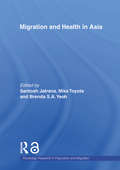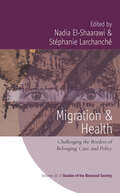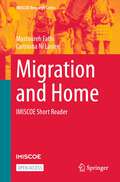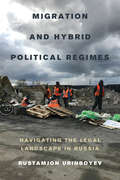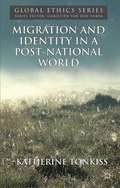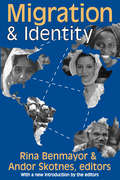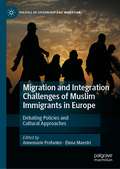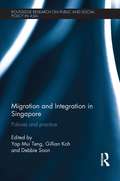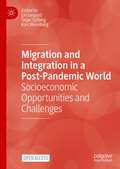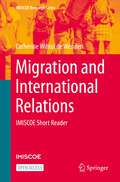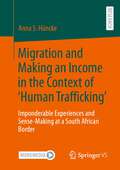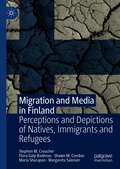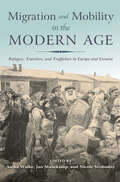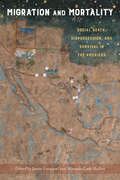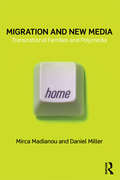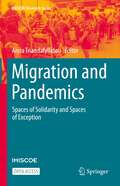- Table View
- List View
Migration and Health
by Sandro Galea Muhammad H. Zaman Catherine K. EttmanA new introduction to a timeless dynamic: how the movement of humans affects health everywhere. International migrants compose more than three percent of the world’s population, and internal migrants—those migrating within countries—are more than triple that number. Population migration has long been, and remains today, one of the central demographic shifts shaping the world around us. The world’s history—and its health—is shaped and colored by stories of migration patterns, the policies and political events that drive these movements, and narratives of individual migrants. Migration and Health offers the most expansive framework to date for understanding and reckoning with human migration’s implications for public health and its determinants. It interrogates this complex relationship by considering not only the welfare of migrants, but also that of the source, destination, and ensuing-generation populations. The result is an elevated, interdisciplinary resource for understanding what is known—and the considerable territory of what is not known—at an intersection that promises to grow in importance and influence as the century unfolds.
Migration and Health
by Sandro Galea Muhammad H. Zaman Catherine K. EttmanA new introduction to a timeless dynamic: how the movement of humans affects health everywhere. International migrants compose more than three percent of the world’s population, and internal migrants—those migrating within countries—are more than triple that number. Population migration has long been, and remains today, one of the central demographic shifts shaping the world around us. The world’s history—and its health—is shaped and colored by stories of migration patterns, the policies and political events that drive these movements, and narratives of individual migrants. Migration and Health offers the most expansive framework to date for understanding and reckoning with human migration’s implications for public health and its determinants. It interrogates this complex relationship by considering not only the welfare of migrants, but also that of the source, destination, and ensuing-generation populations. The result is an elevated, interdisciplinary resource for understanding what is known—and the considerable territory of what is not known—at an intersection that promises to grow in importance and influence as the century unfolds.
Migration and Health
by Sandro Galea Muhammad H. Zaman Catherine K. EttmanA new introduction to a timeless dynamic: how the movement of humans affects health everywhere. International migrants compose more than three percent of the world’s population, and internal migrants—those migrating within countries—are more than triple that number. Population migration has long been, and remains today, one of the central demographic shifts shaping the world around us. The world’s history—and its health—is shaped and colored by stories of migration patterns, the policies and political events that drive these movements, and narratives of individual migrants. Migration and Health offers the most expansive framework to date for understanding and reckoning with human migration’s implications for public health and its determinants. It interrogates this complex relationship by considering not only the welfare of migrants, but also that of the source, destination, and ensuing-generation populations. The result is an elevated, interdisciplinary resource for understanding what is known—and the considerable territory of what is not known—at an intersection that promises to grow in importance and influence as the century unfolds.
Migration and Health in Asia (Routledge Research in Population and Migration #10)
by Mika Toyota Brenda S.A. Yeoh Santosh JatranaThe processes of migration and health are inextricably linked in complex ways, with migration impacting on the mental and physical health of individuals and communities. Health itself can be a motivation for moving or a reason for staying, and migration can have implications on the health of those who move, those who are left behind, and the communities that receive migrants. This volume brings together some of the increasing number of researchers who are studying health and migration in Asia - a continent which is a major exporter and importer of human resources. Using both quantitative and qualitative approaches, the essays included in this work investigate the interdisciplinary issues of health and health-related behaviours in the field of migration. Comprehensive and scholarly, Migration and Health in Asia also covers major themes such as the pandemics of HIV/AIDS and SARS, differential access to health and civil society for migrants, and the health of the populations who are left behind.
Migration and Health: Challenging the Borders of Belonging, Care, and Policy (Studies of the Biosocial Society #10)
by Nadia El-Shaarawi and Stéphanie LarchanchéDespite the centrality of migration in our contemporary world, scholarship on mobility and health frequently separates migrants according to legal status, country of origin, destination, or health concern. Yet people on the move and health systems face challenges and opportunities that transcend these boundaries, including border fortification, neoliberal agendas, and climate change. This volume explores these epistemic borders, recognizing the necessity of a new conversation about migration and health. Each of the empirically grounded chapters introduces readers to pressing questions of migration and health in diverse social, political, and geographical settings.
Migration and Home: IMISCOE Short Reader (IMISCOE Research Series)
by Mastoureh Fathi Caitríona Ní LaoireThis open access short reader offers an intersectional perspective on the meaning of home in migration. The book provides a pathway through existing scholarship on home and migration, exploring how intersectional power relations and transnational migration regimes are felt, experienced, lived and navigated by migrants, who are differently positioned, in the making and imagining of home. The meanings associated with home are composed of the interrelation of places, spaces, people, social relations, materialities, emotions and temporalities. These multiple aspects highlight the complexities inherent in the idea of home, which come to the fore particularly when one moves location. Migration and Home explores these issues by focusing on specific key aspects of home in migration: home and gender; home and age; home and materiality; and home and migration status, class and race. It proposes the concept of structural im/possibilities as a framework for understanding the power relations and structures that shape where, when and for whom home in migration is more, or less, possible.
Migration and Hybrid Political Regimes: Navigating the Legal Landscape in Russia
by Rustamjon UrinboyevA free open access ebook is available upon publication. Learn more at www.luminosoa.org. While migration has become an all-important topic of discussion around the globe, mainstream literature on migrants' legal adaptation and integration has focused on case studies of immigrant communities in Western-style democracies. We know relatively little about how migrants adapt to a new legal environment in the ever-growing hybrid political regimes that are neither clearly democratic nor conventionally authoritarian. This book takes up the case of Russia—an archetypal hybrid political regime and the third largest recipients of migrants worldwide—and investigates how Central Asian migrant workers produce new forms of informal governance and legal order. Migrants use the opportunities provided by a weak rule-of-law and a corrupt political system to navigate the repressive legal landscape and to negotiate—using informal channels—access to employment and other opportunities that are hard to obtain through the official legal framework of their host country. This lively ethnography presents new theoretical perspectives for studying immigrant legal incorporation in similar political contexts.
Migration and Identity in Central Asia: The Uzbek Experience (Central Asia Research Forum)
by Rano TuraevaThis book is an ethnographic and sociolinguistic study of Uzbek migrants in the capital city of Uzbekistan. The ethnographic details of the book represent post-Soviet urban realities on the ground where various forms of belonging clash and kinship ties are reinforced within social safety networks. Theoretically, it challenges the existing theories of identity and identification which often considered the relations between 'We and Them' taking the 'We' for granted. The book offers in-depth insights into the communication strategies of migrants, the formation of collective consciousness and the relations within the 'We' domain. Constructed around contradictions regarding Uzbek identity and how various groups relate to one another as different ethnic groups, the theoretical argument of the book is built through such methods and analytical tools as strategic rhetoric and discourse analysis, communication and identity theories, and the analysis of power and dependence. The book will be of interest to students and scholars of Central Asian Studies, Migration Studies, and Central Asian Culture and Society.
Migration and Identity in a Post-National World
by Katherine TonkissKatherine Tonkiss offers a succinct account of constitutional patriotism theory, specifically arguing that it involves a commitment to free migration. She draws on qualitative research to explore the implications of this claim for the dynamics of post-national identity and belonging in local communities.
Migration and Identity through Creative Writing: StOries: Strangers to Ourselves (IMISCOE Research Series)
by Anna Triandafyllidou Alka KumarThis open access book brings together storytelling and self-narrative, creative writing and narrative enquiry to explore a variety of topics in migration from an experiential lens. The volume is hybrid and multi-genre as it contains both scholarly chapters grounded in academic perspectives, as well as personal essays and creative non-fiction. In addition to critical reflections on key migration topics and concepts – like, identity and diversity, integration and agency, transnationalism and return – the scholarly chapters also propose a particular methodology for ‘workshopping’ migration narratives, and writing about (personal) lived experiences through iterations of scientific reflection, narrative enquiry, and creative imagination. The book explores the potential of a new conceptual paradigm and methodological process to learn more, and also `differently,’ about the migration experience. Finally, this volume asks a bigger question too – how do we define the boundaries of research; is it possible to entirely separate the spatial, temporal and methodological parameters in which projects are developed and pursued; and how can the specifics of these multiple contexts contribute to shaping the knowledge being produced?
Migration and Identity: Volume Iii: Migration And Identity (International Yearbook Of Oral History And Life Stories Ser. #Vol. 3)
by Rina Benmayor Andor SkotnoesThe theme of Migration and Identity is of special concern at a time both of massive worldwide migration and of apparently intensifying national, ethnic, and racial conflicts. Problems of migration and the resulting reconfigurations of social identity are fundamental issues for the twenty-first century. This volume spans the whole complex global web of migratory patterns with contributions linking Africa, Asia, Australia, Europe, North and South America, without losing the particularities of local and personal experience.This paperback edition in the Memory and Narrative series explores these issues and the sustaining or abandoning of memory and identity as people move between fundamentally different cultures, in a number of recent social settings, from a number of methodological perspectives. These focused "case studies" offer glimpses into the interior migration experiences, into the processes of constructing and reconstructing identity without forgetting that, both theoretically and empirically, the problem of identity is complex and multifaceted. All of the essays rely heavily on oral history and personal testimony, highlighting the experience of individuals and small groups, without ignoring the tension that exists between the local and the global.Memories of oppression or totalitarianism are one of the driving forces behind some of these migrations; and the transmission of memories and myths between family generations is one of the ways in which migrations are interpreted. In looking both backward and forward, Migration and Identity, offers an acute view of migratory patterns and their impact on the newcomers and the local cultures. It will be of interest to cultural and oral historians and researchers of concerned with migration and integration.
Migration and Inequality
by Mirna SafiIn a world of increasingly heated political debates on migration, relentlessly caught up in questions of security, humanitarian crisis, and cultural “problems,” this book radically shifts the focus to address migration through the lens of inequality. Taking an innovative approach, Mirna Safi offers a fresh perspective on how migration is embedded in the elementary mechanisms that shape the landscape of inequality. She sketches out three distinct channels which lead to unequal outcomes for different migrating and non-migrating groups: the global division of labor; the production of legal and administrative categories; and the reconfiguration of symbolic ethnoracial groups. Respectively, these channels categorize migrants as “type of workers,” “type of citizens,” and “type of humans.” Examining this intersection across the U.S. and Europe, she shows how studying international migration together with inequality can challenge nationally established paradigms of social justice. This timely book will be essential reading for all students and researchers interested in the sociology and politics of migration, ethnic and racial studies, and social inequality and stratification.
Migration and Integration Challenges of Muslim Immigrants in Europe: Debating Policies and Cultural Approaches (Politics of Citizenship and Migration)
by Elena Maestri Annemarie ProfanterAs the impetus of globalization continues to gather pace, more and more people leave their homes pursuing dreams of a better life for themselves and their families. Muslim immigrants converging on Europe from widely divergent communities scattered throughout North Africa, the Middle East and South-East Asia, represent a great variety of local cultures and traditions. Trans-Mediterranean networks form the basis of migration routes and are key factors in the destinations of these migrants and in the overall process of immigration, be this towards Europe or other Muslim countries. South-North fluxes intertwine with South-South fluxes, among which the Gulf Arab countries stand out as a prime destination, not only for low-skilled labour. Different situations emerge, within a variegated discourse on co-existence, integration, assimilation and the preservation of identity. The adoption of this transnational dimension incorporating both destination, and points of origin, enables the investigation of migration to move beyond a purely Eurocentric approach. Thus, different national patterns are analyzed with a focus on a number of significant case-studies. By debating policies and cultural approaches the aim is to add innovative scholarship to the challenge of integration. Cross-cultural pluralism on the part of the nation states comprising the European Union is one avenue for moving the dialogue between different cultural frameworks towards a more compatible form.
Migration and Integration in Singapore: Policies and Practice (Routledge Research On Public and Social Policy in Asia)
by Yap Mui Teng Gillian Koh Debbie SoonBetween 2000 and 2010, Singapore witnessed a huge influx of foreign migrants. The proportion of permanent residents in the total population increased from 7% to 11%, while the share of non-resident foreigners has risen from 19% to 25%. This was as much the result of the spontaneous movement of labour to economic opportunities, as it was of active policy direction by the Singapore government. The social impact, both beneficial and disruptive, of this movement was felt at all levels of society, and brought other attending public policy issues to the fore. Taking a multi-disciplinary approach with a focus on policy and practice, this book examines the social, economic, and political issues that have arisen with the influx of foreigners in Singapore since the turn of the 21st century. Drawing on empirical research, it documents the impact of increasing levels of immigration, and provides an analysis of the longer-term implications of these trends, with each chapter covering a different aspect of socio-cultural, political, or economic outcome arising from intercultural contact and adaptation. The contributors also provide policy suggestions to ensure Singapore continues to be a harmonious nation and a cosmopolitan and vibrant global city. Migration and Integration in Singapore: Policies and Practice will appeal to students and scholars of Southeast Asian studies, migration and social policy, as well as to practitioners and policy-makers with an interest in migration in the region.
Migration and Integration in a Post-Pandemic World: Socioeconomic Opportunities and Challenges
by Lin Lerpold Örjan Sjöberg Karl WennbergAs the world emerges from the COVID-19 pandemic, this book explores current migration and integration challenges. Against the background of long-term migration trends, it asks whether the pandemic has changed the patterns observed, transformed the circumstances international migrants face at destination or whether the opportunities and challenges for integration have been altered. Twenty-four researchers have contributed to this volume with research attention on how COVID-19 has affected transnationalism and identity, labour market employment, and impacted the discrimination of migrants in a variety of ways. Loyalties and tensions created by the need to include also hesitant migrant groups in vaccination programmes are explored. The role of cosmopolitanism and welfare chauvinism in narratives on inward migrations flows, the stance of trade unions on migration, the complexities of implementing return policies, and the challenges faced by unaccompanied refugee youth from Afghanistan are also discussed.
Migration and International Relations: IMISCOE Short Reader (IMISCOE Research Series)
by Catherine Wihtol de WendenThis open access short reader investigates how migration has become an increasingly important issue in international relations since the turn of the 21st century. It investigates specific aspects of this migration diplomacy such as double citizenship or bilateral agreements on border controls which can become important tools for bargain or pressure. This short reader also discusses the intersections between migration and international relations concerning issues of global governance such as conflicts and refugees, development and mobility, or environmental migration. The book thereby shows the extent of bargaining involved in migration and international relations, the so called “soft diplomacy of migrations” as seen in the EU/Turkish agreement on borders in 2016, or the EU negotiations with Maghreb or Sub-Saharan countries on read missions against development programs and visas. As such this reader provides a must read to students, academics, researchers and policy makers and everyone who wants to learn more about the international relations aspects of migration governance.
Migration and Making an Income in the Context of ‘Human Trafficking’: Imponderable Experiences and Sense-Making at a South African Border
by Anna S. HünckeThe book focuses on volatile processes at the South African-Zimbabwean border that arise from practices of migration and income generating activities. The processes are influenced by neoliberal developments and controversial discourses on migration, commercial sexual services, and human trafficking. In this unstable environment, different actors continuously negotiate, trying to achieve stable positions. By addressing issues related to migration and income generating activities, they maneuver between legal rules and their own moral values and interests. In their attempt to classify incidents in the border context that are unclear to them, actors’ explanations are partly based on the concept of transnational human trafficking. Thereby, they transfer the impenetrability discursively associated with this concept to what they see as obscure cross-border migration, disconcerting sexual services, and other alienating economic activities. Alternatively, actors understand undocumented cross-border migration, commercial sexual services, and other illegalised income-generating activities as common everyday practices at the border and also assume that human trafficking does not play an important role there.
Migration and Media in Finland: Perceptions and Depictions of Natives, Immigrants and Refugees
by Stephen M. Croucher Flora Galy-Badenas Shawn M. Condon Maria Sharapan Margareta SalonenThis book combines various theoretical approaches to explore how Finland and its people responded to the European Union (EU) refugee crisis. Combining interviews with Finns, voluntary migrants to Finland and refugees in Finland, the text presents differing perspectives on migration in this country. Key themes addressed in the text include the extent to which the different groups perceive one another to be economic, political, and cultural threats to Finnishness. In addition, the cultural fusion of Finnish and migrant culture is presented as a threat and opportunity for Finland and its future.
Migration and Mental Health
by Dinesh Bhugra Susham GuptaHuman migration is a global phenomenon and is on the increase. It occurs as a result of 'push' factors (asylum, natural disaster), or as a result of 'pull' factors (seeking economic or educational improvement). Whatever the cause of the relocation, the outcome requires individuals to adjust to their new surroundings and cope with the stresses involved, and as a result, there is considerable potential for disruption to mental health. This volume explores all aspects of migration, on all scales, and its effect on mental health. It covers migration in the widest sense and does not limit itself to refugee studies. It covers issues specific to the elderly and the young, as well as providing practical tips for clinicians on how to improve their own cultural competence in the work setting. The book will be of interest to all mental health professionals and those involved in establishing health and social policy.
Migration and Mobility in the European Union
by Christina Boswell Andrew GeddesThis book analyses the patterns of migration flow since the end of the Cold War and relates these to political and policymaking processes at EU level and among EU member states. It delivers an original and innovative perspective on the new dynamics of migration policy and the policy dilemmas facing European politicians.
Migration and Mobility in the Modern Age: Refugees, Travelers, and Traffickers in Europe and Eurasia
by Anika Walke Jan Musekamp Nicole SvobodnyCombining methodological and theoretical approaches to migration and mobility studies with detailed analyses of historical, cultural, or social phenomena, the works collected here provide an interdisciplinary perspective on how migrations and mobility altered identities and affected images of the "other." From walkways to railroads to airports, the history of travel provides a context for considering the people and events that have shaped Central and Eastern Europe and Russia.
Migration and Mortality: Social Death, Dispossession, and Survival in the Americas
by Jamie Longazel and Miranda Cady HallettDeath threatens migrants physically during perilous border crossings between Central and North America, but many also experience legal, social, and economic mortality. Rooted in histories of colonialism and conquest, exclusionary policies and practices deliberately take aim at racialized, dispossessed people in transit. Once in the new land, migrants endure a web of systems across every facet of their world—work, home, healthcare, culture, justice—that strips them of their personhood, denies them resources, and creates additional obstacles that deprive them of their ability to live fully. As laws and policies create ripe conditions for the further extraction of money, resources, and labor power from the dispossessed, the contributors to this vibrant anthology, Migration and Mortality, examine restrictive immigration policies and the broader capitalist systems of exploitation and inequality while highlighting the power of migrants’ collective resistance and resilience. The case studies in this timely collection explore border deaths, detention economies, asylum seeking, as well as the public health and mental health of migrants. Ultimately, these examples of oppression and survival contribute to understanding broader movements for life and justice in the Americas.
Migration and National Identity in South Africa, 1860-2010
by Audie KlotzAn extraordinary outbreak of xenophobic violence in May 2008 shocked South Africa, but hostility toward newcomers has a long history. Democratization has channeled such discontent into a non-racial nationalism that specifically targets foreign Africans as a threat to prosperity. Finding suitable governmental and societal responses requires a better understanding of the complex legacies of segregation that underpin current immigration policies and practices. Unfortunately, conventional wisdoms of path dependency promote excessive fatalism and ignore how much South Africa is a typical settler state. A century ago, its policy makers shared innovative ideas with Australia and Canada, and these peers, which now openly wrestle with their own racist past, merit renewed attention. As unpalatable as the comparison might be to contemporary advocates of multiculturalism, rethinking restrictions in South Africa can also offer lessons for reconciling competing claims of indigeneity through multiple levels of representation and rights.
Migration and New Media: Transnational Families and Polymedia
by Daniel Miller Mirca MadianouHow do parents and children care for each other when they are separated because of migration? The way in which transnational families maintain long-distance relationships has been revolutionised by the emergence of new media such as email, instant messaging, social networking sites, webcam and texting. A migrant mother can now call and text her left-behind children several times a day, peruse social networking sites and leave the webcam for 12 hours achieving a sense of co-presence. Drawing on a long-term ethnographic study of prolonged separation between migrant mothers and their children who remain in the Philippines, this book develops groundbreaking theory for understanding both new media and the nature of mediated relationships. It brings together the perspectives of both the mothers and children and shows how the very nature of family relationships is changing. New media, understood as an emerging environment of polymedia, have become integral to the way family relationships are enacted and experienced. The theory of polymedia extends beyond the poignant case study and is developed as a major contribution for understanding the interconnections between digital media and interpersonal relationships.
Migration and Pandemics: Spaces of Solidarity and Spaces of Exception (IMISCOE Research Series)
by Anna TriandafyllidouThis open access book discusses the socio-political context of the COVID-19 crisis and questions the management of the pandemic emergency with special reference to how this affected the governance of migration and asylum. The book offers critical insights on the impact of the pandemic on migrant workers in different world regions including North America, Europe and Asia. The book addresses several categories of migrants including medical staff, farm labourers, construction workers, care and domestic workers and international students. It looks at border closures for non-citizens, disruption for temporary migrants as well as at special arrangements made for essential (migrant) workers such as doctors or nurses as well as farmworkers, ‘shipped’ to destination with special flights to make sure emergency wards are staffed, and harvests are picked up and the food processing chain continues to function. The book illustrates how the pandemic forces us to rethink notions like membership, citizenship, belonging, but also solidarity, human rights, community, essential services or ‘essential’ workers alongside an intersectional perspective including ethnicity, gender and race.

